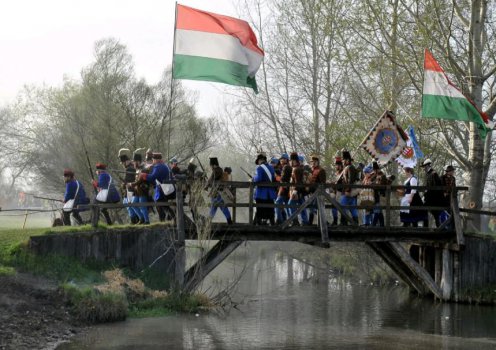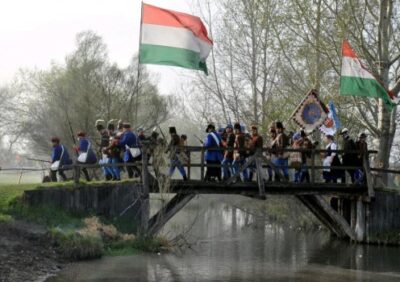High school military programs are spreading in Hungary where the government’s educational policy aims at making students more ‘patriotic.’ The Ministry of Defense is financially supporting historical re-enactors and sports associations as well. The aim of the latter is to give opportunities to children to try different sports, to make them more patriotic and to teach them skills that will support the ‘defense of the nation.’
Csobánc, a hill in Western Hungary near lake Balaton is known for its wine: the volcanic soil gives local wine an extraordinary taste. The hill is in an area called ’Upper Balaton’ that has become a popular spot with wealthy urban people who own holiday homes or vineyards here. With an easy hike on one of the footpaths, you can get to the top of the 376-meter-high hill and wander among the ruins of the Castle of Csobánc. Built in the Middle Ages, it played a key role in the battles between the Ottoman and Hungarian forces in the 16th century. It was abandoned and blown up at the very beginning of the 18th century and is in ruins.
There is a group of people who call themselves the László Gyulaffy Historical Reenactment Horse-Mounted Banderium (Gyulaffy László Hagyományőrző Lovasbandérium). A banderium was a special military unit in mediaeval Hungary. The group was founded in 2003 and named after one of the captains of the Castle of Csobánc.
According to the group’s web page, its members are ten ’horse-mounted soldiers’, fifteen ’foot soldiers’ and ’artillerymen.’ They are working on the reconstruction of the castle and are also taking part in historical re-enactment shows in replicas of 16th-century costumes with replicas of the weapons of the same era. They use swords, daggers, shields and many other ’weapons’ that they list on their website.
The Hungarian Ministry of Defense has been supporting the Csobánc Banderium. In the past five years the group received more than 7,500 euros from the ministry’s fund for NGOs. According to data that Vsquare and its Hungarian partner, Atlatszo received from the ministry, the Csobánc reenactment group was given 4,400 euros total in 2014 and 2015 for ’military reenactment equipment’ and was given another 3,115 euros in 2017 for ’military-educational programs.’
Historical re-enactor groups financed by the Ministry of Defense
The group of re-enactors at Csobánc are part of a group of historical re-enactment societies that are active in Hungary and are partly funded by the ministry of defense. In 2018, the Hungarian Hussar and Military Historical Re-Enactment Alliance (Magyar Huszár és Katonai Hagyományőrző Szövetség) received more than 42,000 euros from the ministry. The Military Re-Enactment Society (Honvéd Hagyományőrző Egyesület) received nearly 8,000 euros. An organization that remembers the victims of the battle at the river Don in World War II (Doni Bajtársi és Kegyeleti Szövetség) received more than 12,000 euros.
According to the data received from the ministry of defense, a total of nearly 125,000 euros was allocated for such historical re-enactment societies, memorial organizations and military history research from the ministry’s NGO fund last year. The Hungarian ministry of defense spent 692,000 euros on this area in the past five year (converted from Hungarian forints, at today’s exchange rate – VSquare).
The money spent on these groups is more or less the same every year, between 110,000-180,000 euros.
However, the entire amount spent by the ministry of defense on NGOs has significantly risen in the past five years. In 2014, the entire amount was 760,000 euros which rose to close to 5.6 million euros by last year. The money spent on trade unions, veterans, cultural programs and historical societies remained roughly stable, though.
The big winner of this category is sports: last year 92% of the MoD’s budget for NGOs went for sports. The Military Sports Association got 3.46 million euros. This is an umbrella organization for seven different sports associations; it was formed in 2017. It includes self-defense, sports shooting and fencing groups, among others.
According to its website, the mission of the Association is to ‘strengthen the relationship between the military and citizens, to strengthen the Hungarian citizen’s patriotic commitment to defend their homeland, to strengthen their readiness for sacrifice, and to include a wider and wider group of citizens in the development and upkeep of the defense capabilities of Hungary in a voluntary manner.’
According to the website of the Association, one of its main goals is to teach skills to children that are useful in the ‘defence of the homeland’ such as map reading and survival skills. The Association stresses that these are not military or fighting skills.
The Budapest Military Sports Association (Budapesti Honvéd Sportegyesület), best known for its soccer team, received 1.27 million euros. The junior soccer academy of the club (Magyar Futball Akadémia Alapítvány) got 234,000 euros.
Patriotism is going to be integrated into the national curriculum
Patriotism is getting a more and more important role in the education policy of the Orban government as well. Since 2013, there is a military high school in Hungary again: the students of the Károly Kratochvil Military High School (Kratochvil Károly Honvéd Középiskola) are all residential students and follow a daily military schedule. The school is funded by the Ministry of Defense, in the 2018 budget 301 million Hungarian forints, approximately 938,000 euros were allocated for the school.
There is also a Cadet Program (Kadétprogram) which started as the Military School (Katonasuli) program in 2005. It was widened and transformed into the Cadet Program in the 2017/2018 academic year. The reason for this was announced at a conference about patriotic education in 2017, when deputy minister of defense Tamás Vargha said that ‘patriotism of citizens is an important pillar of the defense of the country thus the patriotic education of the youth is always a current issue’.
High Schools that join the Cadet Program offer special elective classes to their students. In these classes students can learn basic military commands and formations, learn about military history, map reading and learn about international security issues. The program started with two schools in 2017 but by the 2018-2019 academic year the number of high schools that took part in the program was 54.
In August 2018, more than 140 students who were admitted into the Cadet Program attended a 4-day camp where they took part in sports and military formation activities, went on a canoe tour and visited the site of the Pákozd battle of 1848.
There is criticism of this program in Hungary. According to Tamás Szűcs, chairman of the Democratic Trade Union of Teachers (Pedagógusok Demokratikus Szakszervezete) the military studies subject can be accepted as an elective course, but he would rather not teach any military skills to children under 18, even as an elective course.
‘As a teacher I think it is very important that identity building and a commitment to the Hungarian nation be part of education. But this new course is not doing that but teaching military skills, and the reason for this is most probably to encourage a certain percentage of the citizens to choose this career path’ he told news portal Zoom.hu.
Renowned psychologist Dr. Tamás Vekerdy told the news portal that back in the 1950s he was disciplined for criticizing such military education. ‘I am a pacifist and I think this course is mere stupidity. There is no need for this in schools. The army should promote itself somewhere else.’
However, patriotic education is about to be extended into all schools and curriculums. Former minister of defense István Simicskó was recently appointed as Government Commissioner for Patriotic Education and will serve in this position until May 2020.
In an answer to news channel HírTV Simicskó said that he does not want to introduce a new class in schools but wants to include patriotic education in different, currently existing subjects such as geography and history. He said it is not a goal to make soldiers of every student but to create a ‘healthy national identity’ in schoolkids. And this, he said, would also ‘benefit the defense of the homeland.’
However, this work is reportedly not yet going as planned. Orban’s government is constantly re-writing the national school curriculum. Still, the new history curriculum and new history textbooks that were produced, were judged not patriotic enough.
Moreover, in 2016 Orban announced that he wants shooting ranges to be built around the country. Soon after that his then-top-minister János Lázár announced that the government would spend 27 billion Hungarian forints (81 million euros at today’s exchange rate) in building 197 shooting ranges in the following three years. The aim of the program is to teach young people to shoot ‘in a safe environment.’ Media and the opposition at the time criticized the move as aiming at training the entire population of the country in military skills and creating a huge paramilitary force.
Military expert: historical re-enactors should not be embraced by the military
According to Gyula Kovács, a retired army officer and military expert, the above-mentioned historical military re-enactment groups cannot be considered as paramilitary groups. Neither their equipment, nor their training is sufficient to serve as paramilitary groups. And that is not their aim, either: they are keeping certain traditions alive and create educational and fun experiences for children.
Kovács stresses that there are other groups that have zero military capability but who like to wear military-like clothing and use made-up ranks among themselves. Some of them are the ’Nemzetőr’ groups whose name could be translated as ’national guards’ or ’militiamen.’
According to Kovács, these groups were favored by the Orban government between 1998 and 2002: they were given money and István Simicskó, the chairman of the military committee in Parliament introduced a bill that would have created a separate, armed military group from the Nemzetőr groups. It would have been some kind of a reserve army, but the bill died in the Parliament. Several other, similar initiatives have been floated and abandoned since.
Kovács says that there is no longer any talk about arming them. They keep wearing uniforms that are almost identical to military uniforms and they are embraced by the ministry of defense: their leaders are granted meetings by the minister of defense and there are even receptions held in their honor in the most representative building owned by the military – the Stefánia Palace in Budapest.
Kovács thinks that the Orbán government is favoring these groups because many of them have their roots in the historical era of the beginning of the 1940s when general Horthy was ruling Hungary. Orbán has a nostalgia for that era. The government, for example, has re-built the entire Kossuth Square, the area around the Parliament in the past few years in a way to re-create how it looked ’before 1944,’ that is, during the Horthy era. ’It is a mistake to mix the ministry of defense and the army with these groups’ says Kovács.
A paramilitary that was training together with Russian GRU agents
The real paramilitary groups have never been connected to Orban’s Fidesz and have never been funded by Orban’s governments. Paramilitary groups in the past decades were parts of the extreme right.
When the Hungarian Guard (Magyar Gárda) was formed in 2007 it was in many ways connected to the Jobbik party and it caused considerable anxiety in the majority of the population. The Hungarian Guard was disbanded by a binding court decision in 2009.
Soon after that new, smaller paramilitary groups were formed locally, all connected to the extreme right. They were generally unbothered by the Hungarian authorities and not widely covered by mainstream media until October 2016 when police appeared at the house of István Győrkös, a well-known extremist in Bőny. Győrkös at the time was the leader of the extreme right paramilitary group called Hungarian National Front (Magyar Nemzeti Arcvonal, MNA). When police arrived, Győrkös shot at them and killed a policeman.
It was later revealed that police has been investigating MNA for a year by that time. The nineteen members of the group were uncovered and disbanded by authorities soon after that; police found weapons, ammunition and explosives buried and announced that the group had been organizing ’military training camps.’ Győrkös’s court case is still going on.
Soon after the murder, Hungarian news portal Index uncovered that Russian diplomats had trained together with Győrkös and MNA. Later The New York Times revealed that agents of the Russian secret service, the GRU were meeting MNA and Győrkös at least five times a year.
This article is a part of a research supported by the IJ4EU grant. The IJ4EU fund is not responsible for the content and any use made out of it

Hungarian journalist, works with the investigative outlet Atlatszo. She won the Junior Prima Prize in 2012. Former Fulbright/Humphrey Fellow. Based in Budapest.





